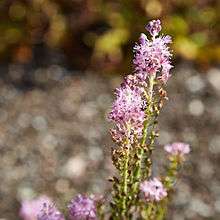Barnardia japonica
Barnardia japonica, the Japanese jacinth, is a bulbous flowering plant in the family Asparagaceae, subfamily Scilloideae (also treated as the family Hyacinthaceae).[1] It is one of the two species of the genus Barnardia, found in east China, Korea, Japan, Taiwan[2] and East Russia.
| Barnardia japonica | |
|---|---|
 | |
| Barnardia japonica | |
| Scientific classification | |
| Kingdom: | Plantae |
| Clade: | Tracheophytes |
| Clade: | Angiosperms |
| Clade: | Monocots |
| Order: | Asparagales |
| Family: | Asparagaceae |
| Subfamily: | Scilloideae |
| Genus: | Barnardia |
| Species: | B. japonica |
| Binomial name | |
| Barnardia japonica (Thunb.) Schult. & Schult.f. | |
| Synonyms | |
| |
Description
The plant bears a terminal raceme of pink small flowers. It is said to resemble a fox's tail. The shape of the plant is elegant.
Systematics and taxonomy
The genus Barnardia was created by John Lindley in 1826 together with the single species B. scilloides. However, this species had already been described as Ornithogalum japonicum by Carl Peter Thunberg in 1784, so that it is now called B. japonica.[2]
The plant forms a genetic complex with two genome types, noted A and B, and diploid, allo-triploid and aneuploid specimens in natural populations.[3][4]
Natural occurrences
In China (Chinese name:棉棗兒 or 绵枣儿), it can be found in Guangdong, Guangxi, Hebei, Heilongjiang, Henan, Hubei, Hunan, Jiangsu, Jiangxi, Jilin, Liaoning, Nei Mongol, Shanxi, Sichuan and Yunnan.[5]
In Northern Taiwan, the plant occupies habitats under 700 meters high in a small amount. From July to August, it can be easily spotted on the open hillsides or fields along the roads in Dongyin and Siyin Island. It also can be found in Nangan, but the majority is in Dongyin and Siyin. It has been listed as a candidate for 'Township Flower' in Dongyin.
In Russia, it is found around Vladivostok, though it is probably extinct there (according to the Red Data Book of Russia).
Cultivation
Barnardia japonica is cultivated as an ornamental bulb. In a temperate climate it requires a sunny position where it flowers in the autumn. As well as the normal pink-flowered form, a white form (Scilla scilloides var. albo-viridis) is in cultivation.[6]
Uses
The leaves and roots are edible. The bulbs can be used in medicine.
Chemistry
The homoisoflavones scillavones A and B can be isolated from the bulbs of B japonica.[7]
The bulb also contains eucosterol glycosides showing anti-tumor activities.[8]
References
- Stevens, P.F. (2001–2012), Angiosperm Phylogeny Website: Asparagales: Scilloideae, retrieved 2013-03-28
- "Barnardia", World Checklist of Selected Plant Families, Royal Botanic Gardens, Kew, retrieved 2013-03-28
- Cytogenetics of theScilla scilloides complex. Hiroto Araki, Saburo Hidaka and Seishi Takahashi, The botanical magazine = Shokubutsu-gaku-zasshi, June 1976, Volume 89, Issue 2, pages 83-91, doi:10.1007/BF02491111
- Physical mapping by FISH and GISH of rDNA loci and discrimination of genomes A and B in Scilla scilloides complex distributed in Korea. Hae-Woon Choi, Jeong-Soon Kim, Sang-Hoon Lee and Jae-Wook Bang, Journal of Plant Biology, January 2008, volume 51, issue 6, doi:10.1007/BF03036061
- efloras.org
- Beckett, K., ed. (1994), Encyclopaedia of Alpines : Volume 2 (L–Z), Pershore, UK: AGS Publications, ISBN 978-0-900048-62-3, p. 1203
- A new homostilbene and two new homoisoflavones from the bulbs of Scilla scilloides. Nishida Y, Eto M, Miyashita H, Ikeda T, Yamaguchi K, Yoshimitsu H, Nohara T and Ono M, Chem Pharm Bull, July 2008, volume56, issue 7, pages 1022-1025, PMID 18591825
- Eucosterol Oligoglycosides Isolated from Scilla scilloides and Their Anti-tumor Activity. Sang-Myung Lee, Hyo-Kon Chun, Choong-Hwan Lee, Byung-Sun Min, Eun-Sook Lee and Yung-Hee Kho, doi:10.1248/cpb.50.1245
External links


- "Barnardia japonica" at the Encyclopedia of Life